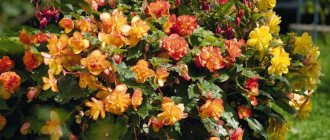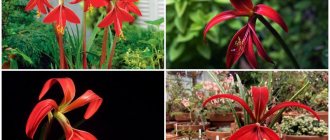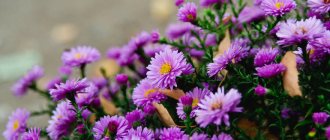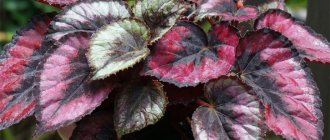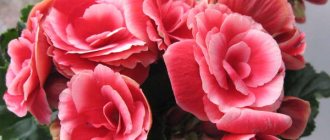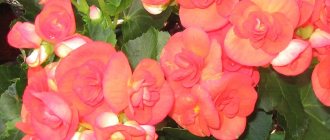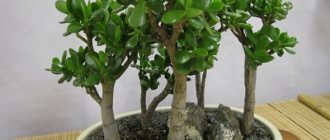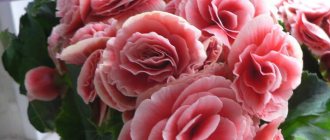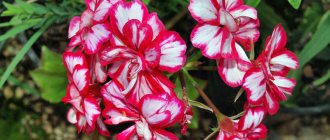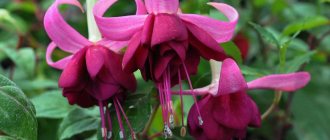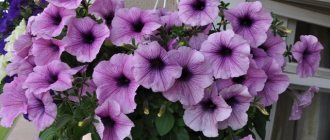Author of the article: Anna Vladimirovna | Updated: 02/23/2022
Ampelous begonia has recently become especially popular among flower growers in our country. This is due to its advantages: beautiful bush shape, bright asymmetrical leaves, rich flowering, variety of flower colors. Caring for it is not difficult - even a beginner can cope with the task. You will learn about the rules for planting such a plant, the nuances of maintaining a house at different times of the year, and methods of reproduction from this material.
Characteristics of the subspecies
A subspecies of tuberous begonias is ampelous, and can also be called cascading or pendula. The latter are often sold in stores as a series of varieties of hanging begonias, with differences in color characteristics.
These are herbaceous plants with a succulent stem, tuberous roots and asymmetrical toothed leaves. The main interest for gardeners is its flowers. Terry varieties of hanging begonias have male and female flowers. The male ones are larger and bloom first, the female ones appear later and are non-double in the structure of the bud. It turns out that one bush can have both double and non-double inflorescences at the same time.
With proper care, the flowering of tuberous begonias is lush, to the point that the foliage is practically invisible because of the flowers. The petals come in different shades of yellow and red, orange, pink, coral and salmon. There are varieties in which the edge of the petal is edged with a different color.
The sizes of flowers vary from small - 2-3 cm in diameter, to giant - 15-20 cm. They are also different in shape: double and regular, similar to roses, peonies, camellias and even daffodils. During the period of active flowering, pendula bushes turn into lush “caps” of bright colors.
Due to the characteristics of hanging varieties, they are used mainly for landscaping terraces and balconies, loggias, shop windows, grown in hanging boxes and flower pots. It grows quite well at home, however, in the warm season it is still preferable to send it to fresh air.
Begonia ampel series Belleconia description
03.12.2016
Begonia ampel series Belekonia (Begonia Belleconia). The flowers are double, large with pointed petals, like dahlias. The leaf is dark green, pointed. The Belleconia series is one of the newest series of ampelous begonias with large double flowers. These plants are highly resistant to diseases and pests. Blooms continuously from spring to late autumn, producing long, drooping graceful cascading shoots 30-40 cm long with bright green foliage and cascades of wonderful flowers. Flowers in ampelous begonia appear at the level of 5–6 leaf nodes. In the axil of each leaf, long peduncles with male (double) and female (simple) flowers with a diameter of up to 8 cm appear. Each flower lasts about 10 days, and a mass of new ones immediately appear to replace the withered flowers. Flowering of adult ampelous begonia begins in mid-May and continues until late autumn. It is better to grow ampelous begonia in a hanging basket or in a vase with a long stem. For abundant flowering of ampelous begonia, you need a sunny place, ideally bright, diffused light. In autumn, spring and winter, begonias can be kept on a south window, on hot summer days they can be placed in an east window or taken out onto a balcony or street into “openwork” shade - this helps keep the foliage green and bright.
Ampelous begonia. Care.
Caring for ampelous begonia is simple. To grow begonias, you need light, fertile soil that is slightly acidic.
With the onset of spring, ampelous begonia develops very quickly, and in the summer it blooms continuously, so in the warm season it needs abundant watering. In winter, watering should be moderate, after the top layer of soil has dried, especially if the plant is on a cold windowsill. You need to remember that watering should be regular, the most important thing is not to overwater or dry out the plant.
For good growth and abundant flowering, ampelous begonias must be fed. In early spring, begonias can be fed a couple of times with fertilizers with a high nitrogen content, and during the flowering period, the plants must be regularly fed with mineral fertilizers for flowering plants according to the instructions. It’s good if you feed your hanging begonias with organic fertilizers two or three times during the summer. Only moist soil should be fertilized.
Unlike other species, ampelous begonia is quite hardy; it can easily tolerate an increase in temperature up to 35°C or a short drop in temperature down to 12°C. Indoor hanging begonia loves fresh air; ventilation strengthens the plant. In a word, if you feel comfortable, then the plant feels good.
Keep the plant clean - remove faded flowers and dried leaves. In the spring, before flowering, give your beauty a warm shower. Do not place a wet plant in the sun - this may cause burns on the leaves. It is better to leave the plant in the bathroom until the morning, and in the morning put the dried begonia on the window.
Ampelous begonia. Reproduction.
Begonia ampelous propagates by cuttings throughout the year. We cut cuttings about 10 cm long from an overwintered plant and place them in water. In water, cuttings produce roots. You should not expect too long roots; it is better to plant cuttings with small roots in light, fertile soil, placing them in a greenhouse or under a bag for a couple of days.
You need to plant 3 cuttings in one pot with a diameter of 18 - 20 cm - then your begonia will be lush and beautiful. For extra splendor, you can pinch the tops of the shoots - this will delay the start of flowering for two to three weeks, but it’s worth it. Fertilizer for begonias. PLANTON S is a fertilizer for flowering plants. This is a fertilizer developed for gardening, which contains a complete set of essential elements for plants and is characterized by a high potassium content. I use fertilizer for flowering plants, in particular for: pelargoniums, balsams, fuchsias, surfinias and other plants; It is also recommended to feed during rain. Increases potassium content, improves proper growth and abundant flowering of plants, and ensures long life of flowers. This fertilizer dissolves well in water, especially warm water. I recommend watering once every 4-5 days with each watering, throughout the growing season, by watering the root system, and it is advisable to use it with each watering. One package is approximately 200 g. It’s enough for me to water 30-40 bushes for a season. When watering with this fertilizer, you need to make sure that it does not get on the leaves and flowers, that is, water at the root. PLANTON S - tested from my own experience, it gave excellent results when used, after application I noticed that young shoots appeared on those bushes that were even drying out. The bushes became more lush, the production of flowers increased and they became more resistant to drought.
How to care for hanging begonia in winter.
Ampelous begonias grow well on the balcony in the open air, but do not forget that begonias are heat-loving plants and cannot withstand even the slightest frost, so before the onset of winter cold they need to be moved indoors in time.
In general, ampelous indoor begonia survives the winter easily. The plant is taking a break from flowering and looks quite decorative. In winter, domestic begonia should be kept in the brightest place. In winter, ampelous begonia is watered with clean soft water without fertilizers, after the top layer of soil has dried. If the shoots become elongated in winter, they need to be shortened at the end of February.
If in the spring you want to cosmetically prune indoor begonias, do not cut them too short, the plant may die. Each shoot should have at least three internodes.
Why do ampelous begonias produce non-double flowers?
Almost all types of beautifully flowering begonias have two types of unisexual flowers - female and male. That is, on one plant there are simple female and double male flowers.
In most cases, a “sweet couple” appears from the axil of one leaf - a male and female flower, as can be seen in the photo on the left. But sometimes only double or only simple flowers appear. If most flowers are double, then flower growers do not pay attention to this, but simply rejoice at the abundant flowering of their begonias. If the flowers are not double, especially if this is the first flowering, panic begins - why does my plant bloom with non-double flowers? The appearance of simple flowers is usually associated with errors in care or unfavorable weather conditions. As soon as the plant gains strength, double flowers will definitely appear.
This begonia reproduces vegetatively (by cuttings). When propagated by cuttings, all the characteristics of the mother plant are transferred to the new plant, including doubleness.
Popular varieties
Garden begonia 'Illumination Apricot'
Some varieties of hanging begonias are combined into series. For example:
- Illumination – plants of this series grow quickly, branch well and bloom luxuriantly. Shoots up to 30 cm hanging. Double flowers with a diameter of 5 to 7 cm. The series is presented in four colors. The most popular variety in the series can be safely called Illumination apricot.
- Sensation is a dwarf cascading begonia with very large double flowers up to 10-12 cm in diameter. The series is particularly resistant to bad weather conditions.
- The variety series Opium, or Odorata, are compact bushes with shoots up to 25 cm and large double flowers up to 10 cm. These begonias are distinguished by the presence of a delicate aroma. Varieties: Begonia Odorata Fragrant Red, Odorata Pink Delight, Opium Red, Opium White
Begonia "Champagne"
And also Cascade Apricot Gold, Double Dark Red and the mesmerizing beauty of Cascade Picotee Florence.
"Cascade Picotee Florence"
Varieties with photos and names
When grown in a winter garden, all old specimens of rhizomatous plants and some other deciduous species with intact shoots can be classified as ampelous. Even in a pot, without pruning, begonias become ampelous:
- Silver Spot;
- Pine seed;
- Naked;
- Humpbacked;
- Bucolic;
- Eelgrass;
- Sisolif.
But the most interesting are the flowering begonias, called pendules, cascades or heralds. These are the ones that are very popular and raise a lot of questions.
Begonia boliviana Bonfire
Ampelous - all varieties and hybrids of Bolivian Begonia belonging to the Lorrain group. It is possible to grow heralds of many tuberous hybrids and elatiors.
The selection shows only some of the popular flowering ampels. A more or less complete picture can be obtained by looking at the catalogs of collectors or sellers of planting material.
Varieties of Bolivian begonia
In the cultivation of Begonia boliviensis there are several very beautiful varieties. All of them, like the species, are ampelous, with bell-shaped corollas with sharp, elongated petals. The branches are thin, curved down, 30-80 cm long. The species plant has fiery red flowers, possible varieties::
- Triumph - available in white and yellow varieties;
- Copacobana - a series with simple corollas of different colors;
- Amber Kiss - lemon and light salmon;
- Bengal fire - semi-double flowers, white with a pale pink tint;
- Chervona - scarlet;
- Rainbow Cascade - caramel, characterized by early bud formation.
Belleconia
Series of begonias with reed root. The flowers are mostly (but not always) swollen, with pointed petals, 8-10 cm in diameter. It has good endurance and spreads quickly. Popular varieties:
- Salmon - rich salmon-colored begonia;
- Soft Orange - creamy orange color;
- Rose - deep pink color;
- Chardonnay - has rounded cream petals with coral touches, crown up to 13 cm;
- Snow - snow-white begonia;
- Elserta - red;
- Tropical sunset with simple flowers;
- Hot Orange - fiery orange;
- Epricot Blush - white with a slight hint of pink;
- Crema - double, dahlia-like, with pointed, pale yellow petals.
Salmon
Rose
Tender orange
Chardonnay
Iconium
A group of terry varieties with beautiful inflorescences and small, compact bushes:
- Miss Montreal - fluffy pink;
- Miss Malibu - with fiery red petals.
Illumination
Series with a purple corolla up to 12 cm on very long stems. Can be grown from seeds. The bush is large and, when properly formed, reaches a meter in diameter. Popular varieties:
- White; White;
- Orange;
- Golden piccotti, golden yellow;
- Scarlett - red;
- Pink - pink.
Chanson
A special feature of the series is that the reddened or half-opened corolla resembles camellia flowers, up to 8 cm in diameter. A tuber-bearing variety, it can be propagated by seeds from trusted breeders. Varieties are named according to color:
- Copper;
- Dark red;
- Pink and white;
- Yellow;
- Salmon.
Funky
Hybrid of the Illumination variety with Bolivian begonia. Can be sown from seeds. The corollas are double or semi-double, with characteristic elongated petals. Varieties:
- Pink - pink;
- Scarlet, red;
- Orange;
- White - white.
Hip-hop
Sold as a mixture of ampelous begonias with large and semi-double, camellia-like flowers with a crown up to 8 cm in diameter. Shrub up to 45 cm.
Alcor
Tuberous ampelous begonia, often grown from seeds, needs a dormant period in winter. The flowers are pink, with rounded petals arranged in several rows, 6-8 cm in diameter. The length of the bush is 30-45 cm.
Gloire de Lorraine
The oldest ampelous variety with delicate, simple, pale pink flowers on very long stems. The peak of its decorative effect occurs in autumn and winter.
Reproduction
There are three ways to get a new plant.
Seminal
Begonia has very small seeds, similar to pollen, so for uniform sowing they should be mixed with sand or ash. This flower is planted for seedlings in January, since hanging begonias need a lot of time to develop.
Caring for baby ampelous begonias is approximately the same as for many other sprouts obtained from seeds. Maintaining a cool temperature (about 19 degrees), two timely picks, as well as fertilizing. Sprouts tolerate transplants well. The flower is planted in a permanent place only after constant warmth has established itself outside.
Young nodules form during the first year of the plant's life. Some experts consider the disadvantage of seed propagation to be the possibility of cross-pollination of different varieties, which leads to a loss of clarity of varietal characteristics. More information about growing begonia from seeds can be found here.
It will be useful to read:
Growing viola from seeds It is difficult to find a plant more charming and beloved by gardeners than viola or violet. And not only gardeners, people...
Cuttings
The process of propagation by cuttings is simpler, however, it also has its difficulties. This is done in spring or autumn. The apical stalk with at least two buds is twisted out of the tuber. The broken areas are treated with crushed coal to prevent rotting. The resulting cuttings are dried for half an hour and then treated with a root formation stimulator.
Then there are two ways: lower it into a deep glass of boiled water, or stick it into nutrient soil.
When choosing the first method: pour just a little boiled water into a tall glass and add a charcoal tablet. Place the cutting on the tablet so that the tail is immersed in water by 1-2 mm. Next, it is necessary to constantly maintain this water level. On the first day, you can cover the glass with a bag, but not for long, because... Too much humidity will cause the stem to rot.
It is important to know! Rooting in water occurs less frequently. And successfully rooted sprouts often do not live long and die after one flowering.
The second method: planting cuttings in nutrient soil or peat tablets with a greenhouse effect (glass cover).
After 2-4 weeks they will take root. After another 1-2 weeks, the rooted cuttings are planted in a pot with prepared soil. You can take a universal mixture by adding a small amount of perlite and coconut substrate. Cover the begonias with a bag until signs of growth appear. All care for ampelous begonias in the first year consists of maintaining the necessary soil moisture without fertilizing.
Tuberous
The ampelous begonia also reproduces by cutting the tubers. The method preserves varietal characteristics as much as possible. To do this, at the beginning of winter, before germination, large and healthy specimens are selected, capable of producing five to nine sprouts.
As a rule, such tubers are more than two years old. The forcing process for them begins earlier than others, because greens are growing slower than usual. The tuber is placed in a moistened mixture of peat and sand. At the same time, the room should be warm and humid.
As soon as the buds begin to hatch, the nodules are removed from the ground. Carefully cut in half or into quarters so that each part has two or three buds left. The body of the slices is treated with a solution of strong potassium permanganate and dried.
Further germination occurs by analogy with ordinary tubers. But make sure that when watering, water does not get on the cuts.
Methods for propagating ampelous begonia
Propagating begonias is not a difficult task. It is important to choose a method suitable for specific conditions and not to deviate from the rules - plant material rots easily.
Seeds
Propagation of ampelous begonia by seeds is suitable for species and many varieties. Sowing is carried out on the surface of a light substrate, previously sprayed with a solution of Fitosporin, or a mixture of peat and sand, and covered with glass. Store in a warm place with high humidity and ventilate daily.
Plant at the 2-3 regular leaf stage. Place under a clear bag or in a trimmed container until the seedlings resume growth.
Most varieties of ever-blooming begonia Ampelous produce buds 4-5 months after the first shoots appear.
Cuttings
The regrown ends of shoots or stems take root well. They are placed in water and immediately planted in separate cups or in a common container filled with:
- peat;
- sand
- perlite;;
- vermiculite;
- light soil.
Cover with clear cellophane and store at high humidity and temperature. Begonias root most quickly if cuttings are taken at the beginning of flowering.
Dividing the bush
This method is not suitable for tuberous species. When transplanting an adult plant, carefully divide the begonia into several parts, each of which should contain at least one shoot and shoots. Usually you don't even need a knife for this.
Then shorten the above-ground part, plant it in a separate pot with fresh soil and cover with cellophane until the partition begins to grow. Treat immediately as an adult begonia.
By dividing the tuber
Cut off old large tubers when new shoots emerge in the spring and reach a length of about 5 cm. Each of them should contain a growing point. The damaged area is air-dried in the shade, dusted with charcoal or fungicide and planted in a small pot.
Caring for young begonias
When the new begonias gain strength and grow noticeably, you need to pinch the top for better branching of the bushes.
During the first winter, the young plant does not need to be sent into hibernation, but it will have to be illuminated. In the spring, you should pinch off all elongated shoots and transfer the grown flowers into pots or flowerpots 15-20 cm wide. Often, for a spectacular flower cascade, several tubers are planted in large pots, for example, 2 begonia tubers will fit in a wide rectangular flowerpot 50 cm wide.
It will be useful to read:
Planting and caring for anemone An ancient Greek legend says that the anemone grew from the tears of Aphrodite, mourning her murdered lover. Beautiful…
Problems during cultivation
Most often, ampelous begonia suffers from improper watering and water getting on the vegetative organs. The plant suffers from spots and gray mold, and in open ground - from mildew. The following pests pose a threat:
- thrips;
- worms;
- spiders;
- nematodes;
- scabies.
Flower growers may encounter problems:
- Beginning in the second year, continuously flowering begonia produces fewer buds; It is better to re-sow or root cuttings every season;
- The tips of the leaves dry out if they are not kept moist;
- light spots on the plates occur due to sunburn or frostbite;
- Tubers of hanging begonia can rot if stored improperly;
- lack of flowering with a lack of potassium, excess nitrogen;
- leaves curl and dry out due to heat and/or poor watering;
- Blades rot due to excessive watering, especially in combination with low temperatures;
- slow growth - the bush does not feed well.
Planting and caring for hanging begonia at home can be considered simple with some difficulties. Plants are not as capricious as rhizomatous ornamental deciduous species, but are sensitive to errors in watering and react poorly to drafts, heat and temperature changes.
Begonias in the garden
Landing location
When choosing a place for future cultivation, you must remember that in its homeland, ampelous begonia lives in the subtropics. Therefore, I got used to the bright but scattered sun. In summer, it is better to take flowers out into the fresh air, placing them in bright places under the direct sun, ideally in diffuse shade. Begonias need a well-lit habitat, but they really do not like heat.
When there is insufficient light, they stretch out, and in the heat the branches become exhausted. In both cases, the bushes do not gain powerful green mass, and therefore flowering becomes scarce or development stops altogether.
Priming
Ampelous begonia loves light nutritious soils, such as chernozem, but does not tolerate hard soil and crust on its surface. Therefore, the soil must be loose, breathable and nutritious.
Sandstone enriched with leaf humus and peat is perfect. This soil mixture will create excellent conditions for the drainage of excess moisture and saturation of the roots with air. If the site is dominated by heavy loamy soils, you can dilute them with the same sand, peat or leaf humus.
Watering
This beauty loves water. However, watering during the growth of green mass should be more frequent and abundant than during flowering. Overdrying the soil is less dangerous than flooding, but it is best to avoid it. It is better to water in the morning or evening, before the sun reaches its peak activity, with soft, settled, warm water.
Avoid getting water on the leaves - this can cause burns.
Feeding
It is best to feed the plant once every 2 weeks with universal mineral fertilizers, for example, Kemira Lux (N:P:K - 16:20.6:27.1) or similar. But if you overdo it with organic matter, the green mass of the plant will grow actively to the detriment of flowering.
Rest period
In early autumn, the leaves of tuberous begonia turn yellow and gradually fall off. At this time, remove all fertilizing and reduce watering to a minimum.
When only one tuber remains from the begonias, they are dug up and dried in a warm room for one to two weeks. Then they are sprinkled with sand or peat and sent to the cellar or any unheated room. Ampelous begonias do not require any other care at this time.
Transplanting ampelous begonias
Tuberous species require low pots with a diameter of 10-15 cm. Thus, the plant will bloom faster, reducing the likelihood of acidification of the substrate or rotting of the underground part.
Ampelous varieties of shrubs should be planted in tight containers of the correct shape. Place several seedlings in large planters to encourage them to envelop the root ball more quickly.
Pots must have holes in the bottom and drainage - this increases the supply of oxygen to the roots, which is very important for the culture.
For planting, you can purchase specialized Begonia soil, or prepare the substrate yourself from the following components:
- leaf humus - 2 parts;
- turf land - 1;
- garden soil - 1;
- sand or perlite - 0.5.
Shrubby amphipelic begonias are replanted annually, deepening the shoots by 2-3 cm. But it is better to root cuttings from the mother plant - this way the flowering will be more abundant.
Tuberous varieties that have overwintered in a pot should be replanted every 2-3 years. If the underground part of the ampelous begonia spent a dormant period in sand or sawdust, then in the spring, when the sprouts germinate and grow a little, they are planted in a fresh substrate.
Common Difficulties in Growing Begonias
Sometimes during the growth process of ampelous begonias, disruptions occur and buds appear earlier or simultaneously with the leaves. In this case, it is necessary to cut off all the buds to stimulate the formation of the first foliage. Otherwise, the first buds will most likely be non-double or mutate in some way. After this pinching, you should fertilize the bushes once a week with mineral fertilizer in the ratio N:P:K - 20:20:20.
Also, when shoots bloom profusely, it often happens that the shoots cannot withstand their own weight and break off. This can be prevented by tying the plant to special decorative supports in advance.
The queen of flower beds and her neighbors
Ampelous and cascading begonias look great on their own - in hanging containers for vertical gardening, either in the garden or indoors.
However, you can use its ground cover property when creating the center of alpine slides or raised flower beds.
It will look great with any green plants. For example, next to a cineraria pubescent with silvery hairs. Its delicate and modest branches perfectly highlight the beauty of begonia.
Also, begonia often coexists in flower beds with marigolds, chrysanthemums, asters, and bells. The main condition is that the plants must not only look beautifully combined, but also have similar growing conditions. It would also be wise to combine plants with different flowering periods in the flowerbed - so that when some fade, others bloom.
